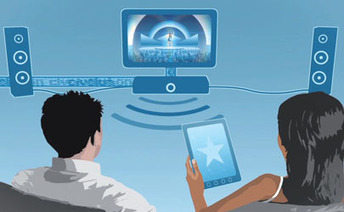 Your new post is loading...
 Your new post is loading...
World’s first subtitling technology that uses “Automatic Contents Recognition” to Identify, Sync and Service your subtitles or captions - efficiently and effectively... To any device, in any workflow.
Civolution has been demonstrating some of the potential new services that become available when using real-time content recognition on Smart TVs. At ANGA Cable last week the company was demonstrating its SyncNow – Smart TV product, which uses a software client in the connected device to understand what the viewer is watching at any given moment, so that complementary services can be layered on top. Most notable is the ability to adjust parental guidance while a movie is playing so that the scenes in that content are edited on-the-fly to match the selected age restriction. In the Cologne demonstration, the company showed a scene from Harry Potter where Harry has a dagger held to his throat. An age restriction (e.g. 13 or PG – Parental Guidance) was then applied and the content shown again. This time, an understanding of which point in the movie the viewer has reached, combined with metadata about the movie scenes, meant the movie skipped the offending scene, in what amounts to real-time, self-editing for VOD. Pim Hertogs, Product Manager at Civolution, noted that there are companies that also sell subtitling online. If you want a specific language and that language option is not supported on a movie, you can source the subtitles from the Internet and these are then overlaid on the video stream. Once again, the content recognition client (audio recognition in this case) in the device means the television is no longer a ‘dumb’ display simply playing out the content as it is received. Instead, the television can synchronise the subtitles to the scenes the viewer is watching.
Trickplay and Audible Magic today announced a technology partnership that will make Audible Magic’s industry-leading automated content recognition (ACR) solutions an integral part of Trickplay’s digital TV software platform. Based on Audible Magic’s patented digital fingerprint content identification technology, the company’s SmartID and SmartSync solutions enable consumer electronics devices to provide more engaging content and offer other outstanding user experiences.
The Audible Magic solutions enhance Trickplay’s platform in two specific ways. SmartID, for example, enables developers to recognize content that is being played, whether the content is delivered from terrestrial broadcast, cable, Internet streaming, Blu-ray, or another source. And SmartSync synchronizes events to the media being watched with frame-to-frame accuracy.
"Gracenote is about to introduce its very own second screen content recognition platform at CES. The company, which became a wholly-owned subsidiary of Sony three years ago, aims to compete with similar solutions from Yahoo’s IntoNow and social check-in services like Miso and GetGlue."
IntoNow from Yahoo! introduces a true TV companion experience with synchronized news headlines, in-depth sports stats, and tweets from your favorite actors.
A top YouTube engineer gave Streaming Media Europe attendees a peek at how the video giant operates. YouTube's Content ID creates a fingerprint of uploaded reference material, then compares it not only to newly uploaded videos, but to every video ever uploaded to the video sharing powerhouse. And it does it in minutes. "It uses a hell of a lot of computers to do that," said Oliver Heckmann. Heckmann, the engineering director for YouTube Europe, gave the second day keynote address at Streaming Media Europe. In a rare peek inside YouTube's operations, he gave stats on the site, explained how the Content ID system works, and gave a glimpse at the upcoming video ad formats YouTube will use to keep both advertisers and viewers happy. YouTube currently receives 48 hours of uploaded video each minute, Heckmann revealed. It serves 3 billion video views per day (a number that's been growing by 50 percent year-after-year) to 500 million unique users worldwide. Besides being the largest video site in the world, it's also the second largest search engine (after parent Google) - and it's not even a search engine.
|
France Telecom’s Viaccess-Orca launched a service package for second screen integration and engagement with a focus on enhanced metadata at IBC2012. Called DEEP (Data Enrichment and Engagement Platform), the package enables pay TV operators to link PCs, tablets, smart phones, games consoles and other IP devices in the home more tightly to the service, and stimulate further activity around the content. DEEP builds on existing standards such as DLNA (Digital Living Network Alliance) and UPnP (Universal Plug and Play) that facilitate automatic device discovery, and also on browser technology, adding new metadata creation methods developed by Viaccess-Orca itself, along with key contributions from two partners, TVersity and Audible Magic. TVersity provides the media server technology on top of DLNA, UPnP or the browser to enable devices to exchange content, supporting games consoles, most set top boxes, Blu-ray players, smart TVs, phones, PCs, and tablets. This comes as software loaded onto a PC, which can then discover devices automatically if they are DLNA or UPnP client. If not then the device can join in by pointing its browser to the PC. Audible Magic’s contribution is its patented SmartID and CopySense automated content recognition (ACR) system using digital fingerprint technology to identify content by analyzing either audio or video image signals. Audible Magic claims that the system identifies content correctly over 99 percent of the time with zero false positives, at sub-second response time, and can do it on video clips down to five seconds in length.
Civolution announces that it will be demonstrating its new real-time content triggering service at the 2012 International Consumer Electronics Show (CES). The new service enables synchronized ad delivery to second screen applications by leveraging Civolution’s extensive broadcast monitoring infrastructure of more than 1,700 TV channels worldwide, of which more than 1,250 are national and local channels in North America covering all 210 Designated Market Areas.
The new content-triggering service complements Civolution’s award-winning SyncNow - 2nd screen synchronization solution. Upon client-based identification through audio watermarking or fingerprinting, the SyncNow product enables identification and synchronization between broadcast, on-demand or recorded television content and interactive applications on devices such as a tablets, smartphones or laptops. Additionally, Civolution is providing automatic content recognition technology for integration with smart TVs, enabling all the value-adding opportunities of SyncNow on the larger main screen of the TV set itself.
Although content distributors have recently gotten the message on audio operations — in the form of federally mandated requirements on commercial and program loudness — the issue of well-managed A/V sync remains unresolved. Despite awareness by program distributors, this problem has persisted, with digital technology both exacerbating it and providing solutions for it.
Managing A/V sync consists of four basic elements: specification and design of equipment and systems, synchronization measurement, correction, and operational diligence. Specification requires a mind-set to plan and manage the issue in new and existing infrastructures. Equipment is available that can measure A/V sync, either out-of-service (using flash-and-beep or similar technologies), or in-service, using watermarking or fingerprinting.
You are a TV channel exec, a content owner, a third party service provider or a video architect/developer and you want to build a synchronized second-screen service ?
Here is a panorama of the solutions available on the market for your project, using watermarking, fingerprinting or other technologies : Nielsen Media-Sync, Civolution VideoSync, Intrasonics, Technicolor MediaEcho, Zeebox, Zeitera, Never.no & many others...
Recently, Ensequence and Zeiteraannounced a new partnership for companion app publishing using automatic content recognition (ACR). I found this quite intriguing. I couldn't recall any other ACR companies doing deals with ITV publishing companies. Something was different. Before proceeding, let's refresh what this is about. ACR has become a buzzword of sorts and the lines describing various uses of automatic content recognition are starting to blur. ACR--What It Is. ACR systems match the audio or video that a sensor is detecting with a database of known audio/video signatures or "fingerprints."
New York-based startup Umami will jump into the "second screen" fray with the expected release in the next few weeks of an iPad app, free to consumers, that will serve up contextually relevant content for shows on 40 broadcast and cable networks. Umami fingerprints the audio in TV content across the 40 networks using a large-scale digital video recorder system. When a user fires up the app, it "listens" for which channel is currently on by comparing it to the Umami fingerprint database, then pulls up news, cast pages, episode guides and social media feeds from various sources in a flipbook-like format. The system works on DVR recordings, too.
|





 Your new post is loading...
Your new post is loading...

















Interesting approach...